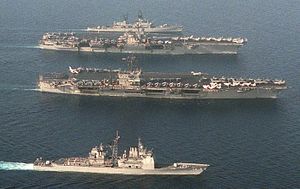The Federation of American Scientists (FAS) has published declassified documents on the disposition of U.S. nuclear weapons at sea during the Cold War, detailing the extensive preparations that the U.S. Navy (USN) took to fight a nuclear war at sea.
The afloat nuclear arsenal included a wide array of weapons, including carrier-borne nuclear gravity bombs and nuclear depth bombs, nuclear-armed torpedoes, nuclear-armed anti-submarine missiles, nuclear land attack cruise missiles, and, of course, submarine launched ballistic missiles. Carriers, surface warships, and submarines each carried an array of weapons, designed for either tactical or strategic purposes.
The USN deployed most of its nuclear combat power to the Atlantic, with the Pacific making up roughly a quarter of the total numbers. By the 1970s, weapons afloat constituted nearly a third of the entire U.S. nuclear arsenal. This number has dropped somewhat since the end of the Cold War, as tactical nuclear weapons have left the arsenal, and as the overall size of the nuclear stockpile has dropped.
Hans Kristensen of FAS contrasts the data on the extent and location of the arsenal with the publicly known nuclear accidents of the Cold War. The USS Enterprise suffered a severe fire in 1969, potentially threatening both its arsenal of nuclear bombs, and its nuclear propulsion system. Nuclear armed American vessels repeatedly collided with each other, and with their Soviet counterparts. In 1975 (November 22, the 12th anniversary of President John F. Kennedy’s death), the USS John F. Kennedy rammed and nearly sank the cruiser USS Belknap. Both ships carried nuclear weapons. The FAS article on the report details a variety of collisions between U.S. and Soviet submarines and surface ships, collisions which often threatened the destruction of either ship.
And of course, the United States Navy has lost nukes. An A-4 Skyhawk with a nuclear weapon rolled off USS Ticonderoga in 1965, never to be seen again. The accident that destroyed USS Scorpion took two nuclear torpedoes to the bottom of the sea, as well. We still have incomplete pictures of Soviet and Chinese nuclear deployments; especially the former expected extensive use of tactical warheads in naval warfare. Consequently, we don’t know exactly how many warheads have been lost at sea.
The history of accidents helps explain why many countries grew nervous about U.S. naval deployments during the Cold War. New Zealand, for example, refused to allow U.S. port visits, leading to diplomatic retaliation from the United States. The U.S. removed tactical nuclear warheads from its ships shortly after the end of the Cold War, and eliminated all nuclear capability from surface warships shortly thereafter. Fortunately, the emerging naval competition between China and the United States has yet to result in the return of such weapons to the maritime sphere.

































